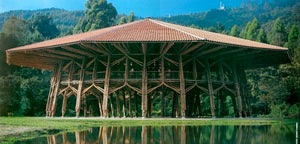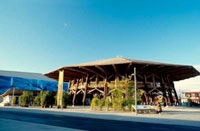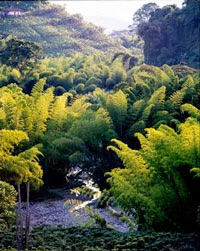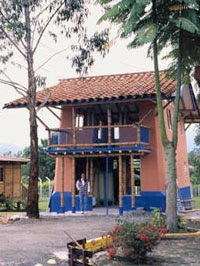Bamboo: Colombia
PICTURE ZERI Pavilion in Manizales, Columbia. Design by Simon Velez, built on land provided by the Caldas Committee of the Coffee Federation, and funded by the Manizales Chamber of Commerce, chaired by Dr. Mario Calderon.
The Global ZERI Network participated in the World Expo in Germany in 2000, designing and building a bamboo structure that has become a landmark in sustainable architecture. The pavilion was designed by Simon Velez of Colombia and underwent a series of scientific tests in collaboration with several academic institutions: University of Braunschwieg, University of Stuttgart, and Science University of Bremen. The building was erected first in Colombia, then in Hannover and received 6.4 million visitors during the 5 month Expo.
ZERI did not embark on the construction of this magnificent building just for the sake of building it. It was a major effort to change the image of bamboo; the majority of the estimated one billion people who use this readily available building material consider it to be a symbol of poverty. The intention of this project was to create a unique structure that would instill pride in and stimulate the use of this abundant, fast-growing construction material. After its remarkable presence at the World Expo in Germany, the pavilion was reconstructed in Manizales, Colombia where it now serves as a symbol of pride for the surrounding coffee farmers.
PICTURE The ZERI Pavilion at the World Expo.
In addition to the pavilion, a model farmhouse was also constructed here in the center of the Coffee Region of Colombia that is also in the heart of the Guadua angustifolia, the bamboo species that is preferred for construction. The region is highly productive in coffee, bananas and herbal teas and has already been introduced to ZERI principles with the growing of shiitake mushrooms on coffee waste.
The typical stone and bamboo farmhouses have given way to simple shelters that are not resistant to earthquakes, which are often risking the livelihoods of the population. The opportunity to design a farmhouse inspired by the ZERI Pavilion, using basically the same construction techniques and stability systems, one can indeed conclude that this farmhouse is the most solidly tested in the developing world. Thanks to its tilting walls, a signature feature of Simon Velez, the house "dances" along with the rhythm of the earth.
On no more than 100 square meters, one could harvest every year enough bamboo to construct a two story house with a large balcony and double roof (for cooling) for only US$ 1,750, provided the owner builds it mostly himself. The building is CO2 neutral. The Federation of Coffee Farmers funded this housing project; Simon Velez designed the house in the aftermath of the earthquake which devastated the coffee region in January 1999.
PICTURE Guadua angustifolia, growing naturally in Colombia.
The coffee region is known for its cold nights and hot days. The airflow of the farmhouse is designed with all of the ingenuity and simplicity of our friend, the termite. Air tunnels that mimic termite hills are dug into the earth to allow for efficient airflow. During the hottest parts of the day, cool and dry air flows into the building. The air flows through the tunnels constructed below the house, then cools down and condenses. As the hot air is leaving the house, fresh air moves in thanks to the vacuum that is created.
While bamboo is considered a symbol of poverty, a flush toilet is considered a symbol of progress. However, the farms are not connected to a sewage system, with expensive drinking water being used to flush the toilets and send the blackwater into the local creek. ZERI has introduced the toilet design of ecological architect Anders Nyquist of Sweden, a simple yet sophisticated device that respects nature's wisdom in keeping solids and liquids separate from each other. After about two years of curing the solids are used as valuable compost on the farmland. This toilet reduces the daily water needs on the farm from 100 liters/day to 10 liters/day, as 80 liters/day were used to flush.
When the farmer only produced coffee, the only crop he could sell is coffee. Based on the zero emissions concept, the ZERI model farm known as La Mi¤oca in Colombia generates 5 products on the basis of the ecosystem which made his coffee farm so successful in the past: coffee remains the core crop, six different herbal and caffeine free teas, three types of mushrooms, dehydrated bananas and bamboo products.
PICTURE Social housing in Risaralda, Colombia.
The coffee can be farmed ecologically on the condition that the farmer substitutes the monoculture with multicropping. The herbal teas are ideal for multicropping since the elimination of pesticides requires the use of herbal plants. Other herbs will help fight soil erosion typically associated with monocultures. The waste from the coffee is used to farm shiitake, reishi and oyster mushrooms. And the banana trees traditionally provided the shade for the coffee plants, and now provide the raw material for the production of healthy snacks. The herbs, the mushrooms and the bananas are all dehydrated so that the preservation is free of any additive, preservative or coloring agent. It is just like nature had intended it to be.
These four products are now packaged in bamboo and as such the farmer can reintroduce his traditional systems while maintaining a livelihood. His income doubles, while the output of coffee slightly reduces. His children now believe that there is a future on the farm, that there is a quality of life and that living sustainable is not only for the rich in the city, but is actually a prerogative for the people living off the land, living the closest to the land.
The revolution of the farmhouse, hand in hand with the improvement of the livelihood of the farmer and his family, will stem the exodus from rural areas to the city, creating a future generation of farmers dedicated to living in co-evolution with nature.

BOOK GUNTER PAULI FOR A CONFERENCE






